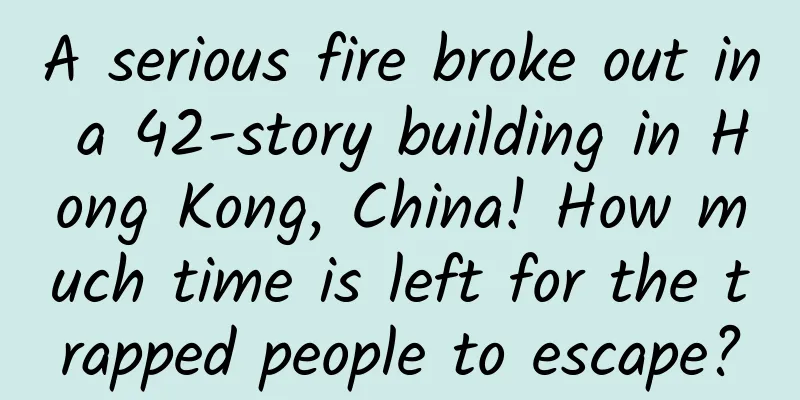A serious fire broke out in a 42-story building in Hong Kong, China! How much time is left for the trapped people to escape?

|
On March 2, 2023, a fire broke out in a 40-story super-high building under construction at 11 Middle Road, Tsim Sha Tsui, Hong Kong. The fire was fierce and quickly spread to the nearby Telecom Building, Far East Building, Hilton Hotel and Chongqing Hotel. Nearby residents have been evacuated urgently. Image source: Toutiao Today, Guangdong, Hong Kong and Macao Observation At around 11pm, a fire suddenly appeared on the roof of a 40-storey building under construction on Middle Road, Tsim Sha Tsui, Hong Kong! More than 30 people reported the incident at the scene, and some of the reporters were in Hong Kong Island and reportedly could see the fire with their naked eyes. The fire started at the former site of the "Seamen's Home". Since 2018, the Empire Group, owned by the famous entrepreneur Guo Binsheng, has invested 6 billion to renovate this building into a hotel project, and it is expected to have 500 rooms after completion. It is near the Peninsula and Sogo department stores. At present, the sparks have splashed to the building opposite, which also caught fire. Image source: Toutiao Today, Guangdong, Hong Kong and Macao Observation According to eyewitnesses, the fire broke out on the top floor of the building, and as the fire spread, burning debris continued to fly around and to the ground. Firefighters and police set up cordons at the scene to prevent citizens from approaching. Firefighters rushed to the scene and tried to put out the fire. After on-site assessment, the fire alarm was upgraded to Level 3 at 11:39 and additional personnel were dispatched to the scene for rescue. At 1:46 this morning, the fire alarm was upgraded to Level 4. Image source: Toutiao Today, Guangdong, Hong Kong and Macao Observation Initial reports said two people were injured, suspected to have been burned by falling sparks, and were sent to Queen Elizabeth Hospital by ambulance for treatment. The Fire Department immediately issued a "Special Notice on Tsim Sha Tsui Fire" to inform the public of the fire. Citizens were advised to close doors and windows and remain calm to avoid being affected by smoke and odors carried by the wind. At the same time, the Hong Kong Transport Department also announced that due to the fire, the entire section of Middle Road between Nathan Road and Salisbury Road has been closed. At the same time, the 1st and 2nd lanes of Salisbury Road (Hung Hom direction) near Middle Road were closed, and the slow lane of Nathan Road (Tsim Sha Tsui direction) between Mody Road and Salisbury Road was also closed. All vehicles along Nathan Road (Tsim Sha Tsui direction) are not allowed to turn left into Mody Road, and drivers are requested to take a detour as much as possible. At around 2am today, many residents of nearby buildings were evacuated due to the fire. As of 2:30am, 50 residents of Myanmar Tower had to be forcibly evacuated, while 40 residents of Chongqing Tower and Far East Tower evacuated on their own. Image source: Toutiao Today, Guangdong, Hong Kong and Macao Observation Fires in high-rise buildings occur frequently However, due to its large size and complex functions Dense population, many sources of danger, and large fire load Once a fire occurs Evacuation and fire fighting It is more difficult Today I will talk to you about high-rise building fires. 1. Why are fires in high-rise buildings so powerful? What is the reason? 1 Flammable and combustible external insulation materials Becoming an important "accomplice" of high-rise building fires my country began to implement building energy-saving policies in 2005. One of the main measures is to add insulation layers to exterior walls. Due to insufficient awareness of the dangers of exterior wall insulation materials and no clear regulations on the combustion performance of the materials, flammable and combustible materials such as polystyrene foam boards or polyurethane rigid foams were mostly used at that time. These materials are extremely easy to ignite and spread rapidly. After burning, they produce a large amount of toxic smoke and pose a great fire hazard. Moreover, high-rise buildings are large in scale, complex in interior, and contain many electrical equipment, fire sources, and combustible materials. A fire may occur if one is not careful. 2 The "chimney effect" causes fires in high-rise buildings to spread rapidly The "chimney effect" refers to the phenomenon that indoor air rises or falls along a vertical slope, causing enhanced air convection. After a fire occurs in a high-rise building, smoke spreads vertically at a speed of 3-4m/s through stairwells, pipe shafts, glass curtain wall gaps and other parts, which can quickly ignite the entire building. 3 "Wind helps the fire" making high-rise building fires difficult to control According to measurements, the wind speed at a height of 10m in the building is 5m/s; at a height of 30m, the wind speed is 8.7m/s; at a height of 60m, the wind speed is 12.3m/s; and at a height of 90m, the wind speed is 15m/s. Since the wind speed increases upwards, after a fire occurs, the wind often helps the fire, and the fire uses the power of the wind to burn more and more vigorously. 2. Why is it difficult to escape from a fire in a high-rise building? 1. The fire causes are complex High-rise buildings usually have complex internal structures and numerous equipment. The fire may be caused by aging internal electrical appliances, or it may be caused by external fireworks and firecrackers igniting flammable materials. There are many factors that cause fire. On the other hand, high-rise buildings have high decoration standards, and many decorative materials and interior furnishings are combustible materials, which can accelerate the combustion rate. Combustible materials can also release a large amount of heat and combustible gases, as well as toxic smoke during the combustion process, which is very dangerous. 2. Fire spreads in many ways and quickly There are vertical pipe shafts such as stairwells, elevator shafts, pipe shafts, cable shafts, exhaust ducts, garbage ducts, etc. in high-rise buildings. These shafts usually run through several or the entire floor. If fire separation measures are not considered in the design or are not properly handled, in the event of a fire, they will become a way for the fire to spread rapidly, just like towering chimneys. In addition, wind factors also contribute to the rapid spread of fires in high-rise buildings. The taller the building, the greater the wind speed. 3. Difficulty in safe evacuation High-rise buildings have many floors, accommodate a large number of people, and have long vertical evacuation distances, so it takes a long time to evacuate to a safe place. When a fire occurs, smoke and fire spread quickly vertically, making safe evacuation difficult. The elevators that are usually used are out of service due to reasons such as lack of smoke and fire protection and power outages. In case of fire, evacuation of personnel mainly relies on evacuation stairs. If the stairwell cannot effectively prevent the intrusion of smoke and fire, the smoke will quickly fill the stairwell and seriously hinder the evacuation of personnel. 4. Difficulty in firefighting Firefighting in high-rise buildings is mainly based on indoor fire water supply facilities. In addition, some high-rise buildings do not have fire elevators. When fighting fires, firefighters have to rush to the high-rise buildings "fully armed", which not only consumes a lot of physical strength, but also "collides" with people evacuating from top to bottom, delaying the firefighting time. If the stairs are blocked by smoke and fire, firefighters cannot rush up, making firefighting work more difficult. 3. How to escape scientifically 1. Please call the fire alarm number "119" immediately. If conditions permit, quickly press the fire alarm button and alert other residents as much as possible. 2. When the fire source is identified and the fire is under control, do not panic. Use surrounding fire extinguishers, fire hydrants and other fire-fighting facilities and equipment to help put out the initial fire. 3. If the fire is obviously out of control, you can follow the "three tips" to escape and save yourself. Tip 1: Escape quickly without smoking Touch the door lock before opening the door. If the temperature is not high and there is no smoke in the stairwell, quickly escape down the stairs and close the fire door when passing through the stairwell. (During the downward escape, if smoke spreads upward and the temperature rises sharply, it is very likely that the evacuation passage below has been blocked by thick smoke and flames . You should evacuate upward as quickly as possible to a room far away from the fire floor and close the fire door in the stairwell, and retreat and wait for help according to "Key 2"). Tip 2: Retreat from the smoke and wait for help If the door lock temperature is very high or there is thick smoke when the door is opened, you should retreat and wait for help. Use clothes, sheets, etc. to block the door gap, and pour water to cool down and prevent smoke . At the same time, call "119" to report important location information such as the trapped floor and room , and send out a distress signal by flashing a flashlight, waving clothes, etc. near the window. Tip 3: Find the fire refuge floor What is a fire refuge floor? Residential or public buildings with a building height of more than 100 meters must have a fire refuge floor. In the event of escape being blocked, people can evacuate to the nearest refuge floor. The purpose of the refuge floor is to provide shelter for people to avoid fire, prevent smoke from entering and causing harm to people, and wait for firefighters to arrive for rescue. A picture teaches you how to identify the refuge layer Taboos and wrong behaviors in fire escape 1. Never be greedy for property! Once a fire breaks out in an ordinary room, the flames will spread and burn throughout the room within 3 minutes, and the smoke is also deadly and toxic! When you are in a fire, you must escape every second. 2. Never take the elevator! When a fire breaks out, ordinary elevators are usually out of power and cannot be used normally. Hot smoke sometimes rushes upward in the shaft at a speed of 3-5 meters per second. If you take the elevator at this time, you will be instantly engulfed by the thick smoke. 3. Never blindly jump off a building to escape! The maximum rescue height of a general life-saving air cushion is 15-20 meters. If you are trapped in a fire scene and your location is more than 6 floors, you must never blindly jump off an air cushion to escape, otherwise the consequences will be almost the same as jumping directly from a building. Four types of wrong behavior; 1. Habitual psychology, that is, escaping by the original route (×) Passengers, customers and tourists in public places are not familiar with the environment and the evacuation routes. When a fire occurs, most of them will run back to the route they came from. If the passage is blocked by fireworks, they will look for other entrances. However, they don't know that the best time to escape has been lost. Therefore, when entering a public place, you must have the necessary understanding and familiarity with the surrounding environment, emergency exits, and evacuation routes to ensure that you can quickly save yourself and escape in the event of a fire. 2. Phototropism, running towards bright places (×) In an emergency, people's instinct, physiology and psychology will always lead them to escape towards light and bright places, but these places may be dangerous places, because in a fire scene, there is a 90% chance that the power supply has been cut off or has caused a short circuit or tripping, and the light and bright places are where the fire demon will show off its power unscrupulously. The correct way is to escape to the nearest emergency exit following the guidance of the illuminated "Emergency Exit" signs. 3. Following the crowd and not having your own judgment in times of crisis (×) When a person's life is suddenly in danger, it is very easy for him to lose his normal judgment and thinking ability due to panic. When he hears or sees someone running in front, his first reaction is to blindly follow closely. Common blind following behavior patterns include: jumping out of windows, jumping off buildings, escaping into toilets, bathrooms, door corners, etc. 4. From high to low, used to running downwards (×) When a fire occurs in a high-rise building, especially a high-rise building, people always tend to think that the fire spreads from the bottom to the top. The higher you go, the more dangerous it is, and the lower you go, the safer it is. The only way to have hope of survival is to escape to the first floor and run outside as quickly as possible. Little do people know that the lower floor may be a sea of fire at this time. It is especially dangerous for old houses with only one evacuation staircase and no fire and smoke prevention functions. Do not escape blindly along the stairs. Instead, you can cover your mouth and nose with a wet towel, pour water on the door to cool it down, or hide on the balcony where there is fresh air. Tell 119 your specific location and wait for rescue by firefighters. 4. Golden time for fire escape Many fires start to get out of control There is a critical point called "flashover" How long does it take from the start of a fire to flashover? Unfortunately, a fire How long do we have to save ourselves? Experiment tells you 25 seconds When the flames first appear, it is generally difficult for people to sense them unless the home is equipped with fire alarm equipment, but this is often the best time to extinguish the fire. 38 seconds When the flame spreads to the sofa, people can sense it through their sense of smell. At this time, quickly use a fire extinguisher or a large amount of water to put out the fire, which can basically solve the problem. However, if you find that the fire extinguishing is ineffective or there are no fire extinguishing tools, you should evacuate quickly, shout loudly and call the police. 54 seconds The wood was gradually ignited by the fire, the temperature in the room rose rapidly, and the fire was out of control. 1 minute 13 seconds The flames were over 1 meter in size and began to produce a lot of thick smoke. 1 minute 35 seconds The flames had reached the ceiling and the room was filled with thick smoke. A large amount of toxic gases such as carbon monoxide were produced in the air. People would lose their ability to move in such an environment within a few minutes. 1 minute 58 seconds The fire was getting bigger and bigger. If people had not evacuated at this time, they might not be able to escape, because the most terrible flashover would occur in the next few seconds. 2 minutes 24 seconds Flashover occurs. Flashover refers to the sudden and comprehensive combustion of a confined space when the temperature reaches a certain level, even if the flame does not touch an object. Experimental results Within one minute of the fire People are relatively safe if they escape quickly Once a fire occurs Everyone must seize the “golden minute” |
<<: Color the ice, add toppings to your friends... penguin poop is more magical than you think
Recommend
What did the Internet giants do on April Fools' Day?
Editor’s Note: Although this year's April Foo...
Can industrial optimization, which is facing a cold situation among color TV giants, reverse the industry's decline?
This year's color TV market is not as smooth ...
After staying up late for three days, the 28-year-old man felt so painful that he wanted to bang his head against the wall! Be careful of this virus, once infected, you will carry it for life!
It’s clearly time to go to bed, but I don’t want ...
In 2017, local subsidies for new energy vehicles were introduced one after another. Which region is the most eye-catching?
Recently, the China Association of Automobile Man...
Weibo, Meipai, and Douyin are all working together. Will dance be the next explosion point for short video content?
A chart I saw a few days ago caught my attention....
This article explains the relationship between CPM, ECPM, and OCPM.
Why is CPM so high? Why is ecpm so high but not m...
Making a fortune in silence: Chinese mobile phones entering the Middle East market
Cross-cultural communication has always faced man...
Android/iOS QQ upgrade: independent password for youth mode
[[408742]] Tencent today released the latest offi...
How do knowledge payment platforms increase user growth? 5 routines!
The middle class’s “knowledge anxiety” has led to...
Apple iOS 13.2 beta adds new feature: can delete Siri dictation history
Apple released the first beta version of iOS 13.2...
Baidu search account setup process!
A good account structure, like a solid foundation...
Want to discover the hidden tricks of WeChat? Have you tried the "long press" function?
[[399085]] Play video silently When we are in a q...
Short video movie app, a sideline project that can earn more than 300 yuan a day
Short video movie app, a sideline project that ca...
Toutiao advertising strategy and channel characteristics
Why are my ads always performing poorly? I think ...
Someone farted during surgery and caused a fire? What else do you not know about the operating room?
Regarding the question of how patients wear cloth...









